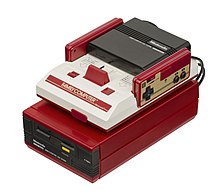
Back نظام القرص فاميكوم Arabic فاميكوم ديسك سيستم ARZ Famicom Disk System Catalan Famicom Disk System German Famicom Disk System Spanish فامیلی کامپیوتر دیسک سیستم Persian Famicom Disk System Finnish Famicom Disk System French Family Computer Disk System Galician Family Computer Disk System Croatian
This article needs additional citations for verification. (June 2023) |
 | |
 Famicom Disk system attached to Famicom | |
| Manufacturer | Nintendo |
|---|---|
| Type | Video game console peripheral |
| Generation | Third generation |
| Release date |
|
| Availability | 1986–1990 |
| Discontinued |
|
| Units sold | 4.4 million |
| Media | 112 KB Floppy disks |
| CPU |
|
| Memory | 32 kB disk cache 8 kB game RAM[3] |
| Sound | 1 extra channel of wavetable synth facilitated by Ricoh 2C33 |
| Successor | (SNES CD never happened) Nintendo 64 Disk Drive |
The Family Computer Disk System,[a] commonly shortened to the Famicom Disk System,[b] or just Disk System, is a peripheral for Nintendo's Family Computer home video game console, released only in Japan on February 21, 1986. It uses proprietary floppy disks called "Disk Cards" for cheaper data storage and it adds a new high-fidelity sound channel for supporting Disk System games.
Fundamentally, the Disk System serves simply to enhance some aspects already inherent to the base Famicom system, with better sound and cheaper games—though with the disadvantages of high initial price, slow speed, and lower reliability. However, this boost to the market of affordable and writable mass storage temporarily served as an enabling technology for the creation of new types of video games. This includes the vast, open world, progress-saving adventures of the best-selling The Legend of Zelda (1986) and Metroid (1986), games with a cost-effective and swift release such as the best-selling Super Mario Bros. 2, and nationwide leaderboards and contests via the in-store Disk Fax kiosks, which are considered to be forerunners of today's online achievement and distribution systems.
By 1989, the Famicom Disk System was inevitably obsoleted by the improving semiconductor technology of game cartridges. The Disk System's lifetime sales reached 4.4 million units by 1990, making it the most successful console add-on of all time, despite not being sold outside of Japan. Its final game was released in 1992, its software was discontinued in 2003,[1] and Nintendo officially discontinued its technical support in 2007.[2]
Cite error: There are <ref group=lower-alpha> tags or {{efn}} templates on this page, but the references will not show without a {{reflist|group=lower-alpha}} template or {{notelist}} template (see the help page).
© MMXXIII Rich X Search. We shall prevail. All rights reserved. Rich X Search